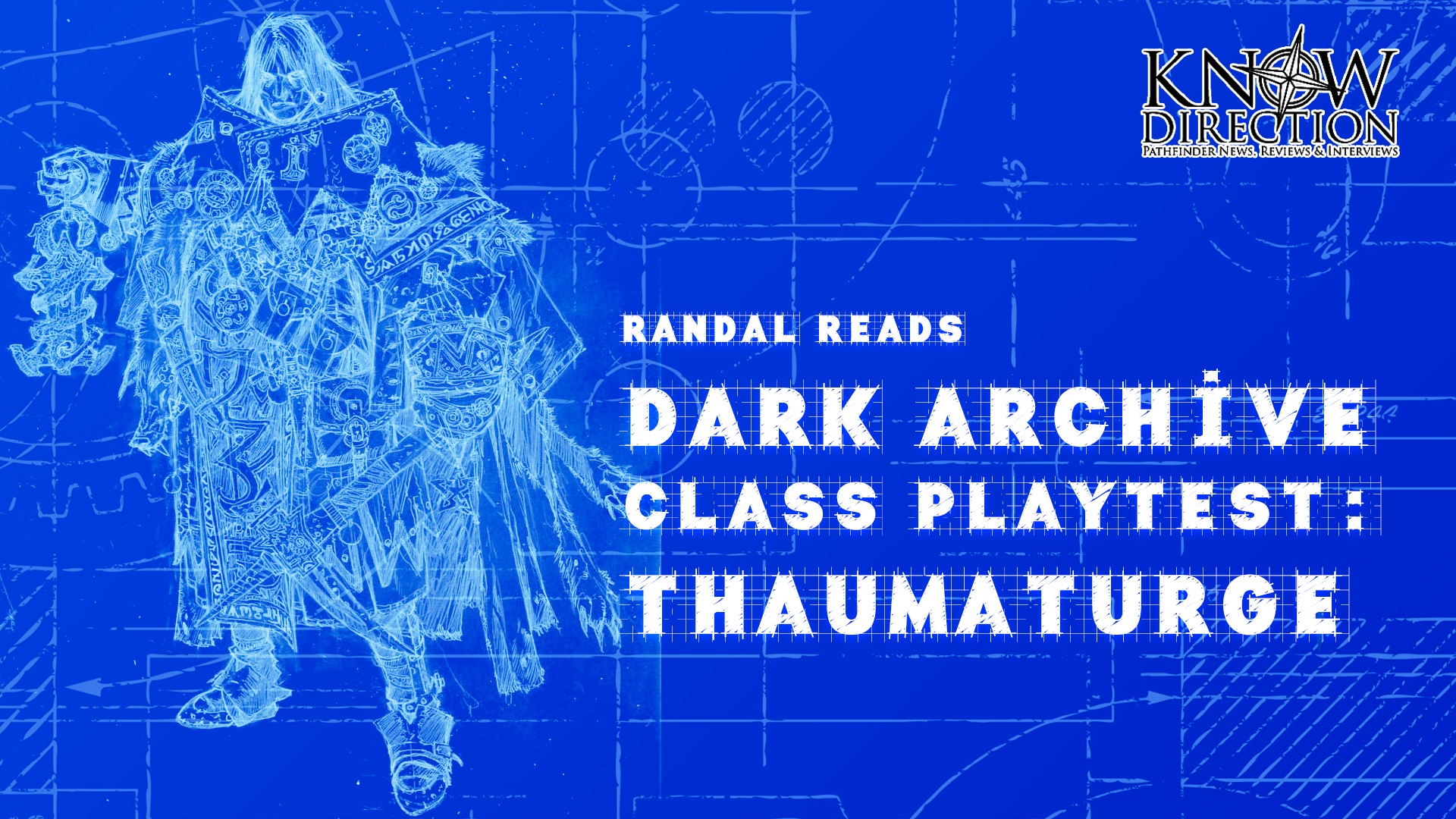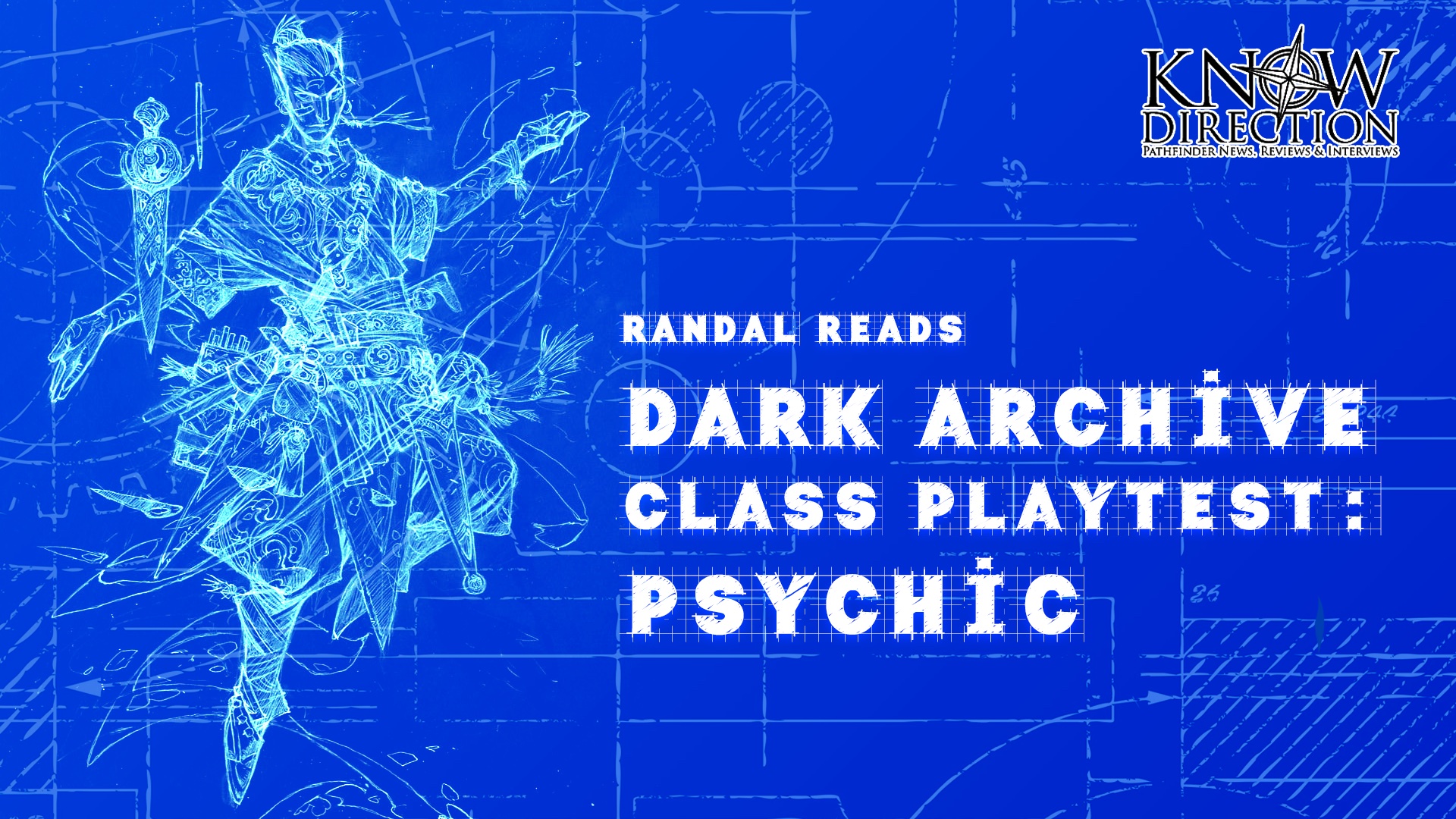Publisher: Paizo Publishing
Pathfinder uses all the 3.5 tools that aren’t bolted to Wizards of the Coast‘s workbench. Since the 3.5 gods are considered WotC intellectual property, Pathfinder needed a slew of new divine beings to answer the calls of clerics. Those divine beings are the focus of Gods and Magic.
Expectations
The title gives one of two impressions. This could be Pathfinder’s answer to Dieties and Demigods, focusing exclusively on divine matters, ie gods and the magic that they grant. Or this is a combination of Complete Divine and Complete Arcane , detailing options and ideas for running characters focusing on divine spellcasting (gods) and arcane spellcasting (magic). Weighing in at 64 pages, this sourcebook would be painfully incomplete if it covered the material equivalent to two books from the first Complete series.
Beyond that, I expect a nice fluffy book that informs and inspires.
At a Glance
Within the Pathfinder Chronicle’s standard letterbox is an epic battle pitting a fire-haired woman with angels wings against a giant worm creature. In this case, the word “epic” is actually used disparagingly. Is this a battle between gods, with the fate of the cosmos in their hands? There is no sense of scale or background, meaning the monster could just be a grub seen up close and the woman the size of a mite. The monster may be terrifying with jagged teeth, multiple eager tongues, and limbs stretched beyond the edges of the cover, but ultimately it is just a big bug with no signs of cultist worshipers or divine powers.
The art accompanying the entry for this monster makes the scope of the battle clearer. It is Rovagug, the god of wrath, disaster, and destruction and it is of Godzillian grandeur, eclipsing a mighty castle or perhaps a walled city. The winged lady fighting Rovagug is Sarenrae the Dawnflower, who would have to be gargantuan to be that big next to Rovagug. The cover’s failure to convey the size of the battle does Gods and Magic a disservice. Wayne Reynold’s talents do not live up to their potential in this case.
The art on the inside is top notch, but with two trends that negatively impact the book the same as the cover: a lack of scale and a feeling of epic but not godly. There are a few gods that stand out, of course. Asmodeus is the perfect blend of a fantasy villain and the Christian devil, cackling over the signed contract and dripping quill in his hand. Calistria The Savoured Sting is loaded with visual elements that tie her to wasps in such an impractical way that she must have great power hidden inside her. And Lamashtu is truly perverse, well deserving of being goddess of madness, monsters, and nightmares.
Highlights
Impeccable Writing
The word ‘impeccable’ has never been used in a review on 3.5 Private Sanctuary. The word carries so much weight, it can only be used sparsely if ever. However, Sean K Reynold’s writing is so good in this book, it warrants the site’s first and possibly only use of impeccable.
Reynolds manages to make twenty-one gods stand out amongst one another as well as amongst all the deities in all the campaign settings that have come before them over the last thirty years. Each one is made an interesting individual, often with unexpected details. For example, Shelyn the goddess of beauty, art, love, and music is said to be the only friend of Zon-Kuthon, god of envy, pain, darkness, and loss. The relationship between these antithetical gods shows that her powers as a love god are greater than his powers as a hate god.
The entries for the major gods share a format, two pages each with themes to the paragraph. You always know that the bottom right paragraph on each entry’s second page will be a description of the god’s church, for example. Many writers might find formulaic writing constricting, but Sean K Reynolds uses the space masterfully and to the benefit of gamers referencing the book.
God-Specific Spells
A nice touch is the inclusion of a new spell per major god. For example, Urgathoa the goddess of gluttony, disease, and undeath has Ghoul Hunger, a mind-affecting spell that forces a target to feast on a nearby humanoid corpse. The nice touch is that these are not just cleric or druid spells. There are spells for any core spellcasting class (including assassins and blackguards) as long as they worship the associated deity. Spell lists are also tailored to specific gods, making which god a PC worships even more important to them.
Magic Items
Thirty-eight magic items are introduced in Gods and Magic, with a few special thematic ties. All the items (except the Holy Mask of the Living God, strangely) have two powers, one that applies to all that use the item, and one that applies specifically to worshipers of the god that created the item. All the items are reasonably inexpensive, between 1500 and 7000 gp, with the majority costing roughly 3000 gp.
There are numerous applications for these specific magic items. A DM can give an evil villain a magic item without worry that the PCs will use the item’s power once the villain is defeated; a church can afford to loan one of these items to the party or offer one as a reward; a PC is not being ripped off if they buy the item but only qualify for the item’s main function; a character wearing or using an item associated with a god other than theirs can be mistaken for a worshiper of that god, for better or for worse.
Low Points
Shifts in Tone
How can impeccable writing have shifts in tone? The problem with these shifts is not the quality of the writing but how foreign they read in a gaming sourcebook. The writing occasionally emulates styles associated with religious texts. The introduction reads very much like Genesis, while the Lamashtu, Mother of Monsters entry reads like Greek mythology. Although the parallel is amusing, the problem is that sourcebooks are not primarily to entertain, and therefore an unexpected shift in tone is not always appreciated. It is very jarring to be reading through magic items written traditionally then reaching the Demon Mother’s Mask, an item that allows the wearer to interbreed with animals. Specifying that the animal must be within one size category of the wearer invokes images of hill giants mating with elephants, images I now share. Enjoy.
Artwork Application
Normally issues with the artwork are handled in the At a Glance category, however the consistency of the problems with the art makes it a low point. Abadar is the first god profiled and he looks like a man in armour. Possibly a general or a battle-ready kind, but nowhere near a god. Desna looks like a fairy. In the real world, if a naked woman with butterfly wings were encountered, she might be seen as a god. But in a fantasy realm, such women are common enough that you might not blink if they served you drinks. Weird things for players are old hat to a PC living in a world where fancy weapons and powerful magic are within mortal grasp. A god needs to jump off the page as the pinnacle of their domains. Looking at artwork of Kord from the core D&D setting, he was a cross between Hulk Hogan, He-Man, and a viking. Everything about him screamed god of strength. Compare that to Pathfinder’s Iomedae, who basically looks like Joan of Arc striking a sexy pose. She resembles a low level paladin. If she instead had skin of gold, armour of diamonds, and a jail hanging off her belt with the trapped souls of the treacherous, then she would look like the goddess of valour, rulership, justice, and honour. The artwork does not think big enough.
A lesser complaint, and one that is consistent with 3.5’s core sourcebooks, is about the holy symbols. Real world holy symbols, like the cross or the star of David, can be drawn by children. That is their purpose, that any commoner can easily illustrate their religion. All of the holy symbols in Gods and Magic look like they are drawn by a professional artist. Technically this art could represent the most elaborate version of the holy symbols, like the centrepiece of a major city’s alter, but including a pedestrian version would better convey how the common worshiper worships.
Fluffy Crunch
A warning to players and DMs that plan to use the spells and magic items in this book: you will be forced to make judgments, read between the lines, and even partially rewrite entries so they read like concrete rules. The Mask of Cutting Flesh says you “lash out at a target” without defining whether this is an attack, a touch attack, or not an attack at all. The Sacrificial Dagger of the Blood Mother “is more of a symbol than an actual weapon” without specifically stating whether it can or cannot be used as a weapon. The Tankard of the Drunken Hero has an effect that “typically occurs about 5 minutes after”. Typically? About? These are not words that describe an effect’s duration. If it is a random duration, there should be a way to randomly determine the duration. If it is not random, it should just state that the effect “occurs 5 minutes after”. After all, non-specific crunch -like exactly how much the Windwave Kit “[aids] in flotation for [creatures heavier than 100 pounds]” – could be the difference between sinking and swimming.
Juicy Bits
Channel the Gift is a spell for worshippers of Nethys, god of magic. Effectively, you cast a third level spell to give a target a free casting of a third level spell they know. The hidden bonus is that secondary casters like bards, paladins, and rangers can use this spell to give primary casters a much more powerful or versatile spell slot.
Fallback Strategy is a useful combat-oriented spell granted by Torag, god of forge, protection, and strategy. As the name suggests, casting this spell provides a back-up plan. It allows you a reroll during the 10 min/level duration.
Droskar’s Guiding Ring is a unique magic item. Linked to the god of cheating, it has a 50% chance of either reducing the cost of items made by the wearer or accidentally making junk.
Personal Experience
So far my gaming group has not used any Pathfinder gods.
Overall
Purchasing this book is making a choice. This sourcebook is about setting-specific gods and therefore only useful in games that use them. This is a fluff book, and fluff books’ lives are tied directly to the quality of the writing. In that regard, Gods and Magic doesn’t just survive, it thrives. If you are tired of your current pantheon, here is a fully fleshed out new pantheon to bring new life into your game.
If You Liked This Book…
It is similar to another Pathfinder Chronicles sourcebook, Classic Monsters Revisited, in that the best part is reading the book.
Gods and Magic succeeds in some areas that Complete Divine fails, like rewarding non-divine casters for their faith.
Date Released: October 2008
Date Reviewed: July 2009



Leave a Reply